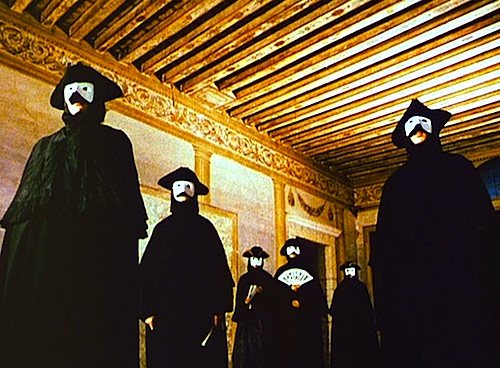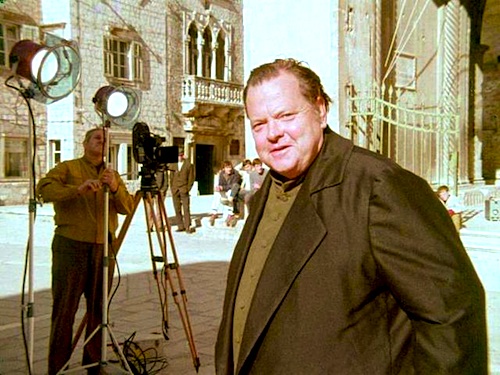
By Joe Bendel. Orson Welles was one of the few theater and film directors who was not afraid to tinker with Shakespeare’s texts. It must have been the confidence that came from being a prodigy. He would therefore be the logical person to adapt and helm a “Reader’s Digest” version of Shakespeare, but he still went way over-budget on his 1969 television production of The Merchant of Venice, forcing CBS to walk away and cut their losses. Long considered lost and unfinished, Welles’ version has been restored and pieced together from disparate sources by the Munich Filmmuseum. The remarkably coherent and satisfyingly Wellesian Merchant of Venice screened last night at MoMA as part of the 2015 To Save and Project International Festival of Preservation’s Unknown Welles sidebar.
As part of a full presentation on Welles in a Shakespearean bag, Filmmuseum director Stefan Droessler also screened a number of interview segments, television guest appearances, and fragments that never really went anywhere, but still involved Shakespeare. It is probably safe to say Welles is the only actor to perform Shakespeare on the Dean Martin Show, Ed Sullivan Show, and I Love Lucy. Nevertheless, Welles’ Shylock was the centerpiece.
Indeed, Welles unambiguously molds Merchant into Shylock’s story. There is only one brief cutaway to Belmont, with the rest was set in glorious Venice, conveniently starring Welles himself as the despised money-lender. Aside from a rather jaunty opening, in which Welles triumphantly returns to Venice (where he also shot Othello) lounging in a gondola, the film is probably the closest in tone to Welles’ The Trial. The entire city seems to be conspiring against Shylock, while wearing sinister carnival masks that weirdly bring to mind Eyes Wide Shut.

Naturally, Welles lost part of the audio track and the negatives, so the Filmmuseum restoration team frequently relied on a 1938 Mercury Theater production initially released as an enormous multi-record set in the days before LPs to fill in audio gaps. Believe it or not, it is not as jarring as it sounds. Unfortunately, they had to resort to inter-titles in occasional spots, but never during a critical dramatic moment. Most importantly, Merchant reflects Welles’ unmistakable sense of visual composition. Even when working in color he creates some starkly striking images.
The Filmmuseum’s restoration recently premiered at this year’s Venice International Film Festival, but it is strange it was not immediately snapped up by someone. Welles’ performance is as strong in Merchant as in any of his later works and his signature style remained undiminished. In this case, the cobbled together restoration should further burnish his reputation. It is too good to simply return to the vault, so Welles fans should keep an eye for it. It was also a great way to kick-off the Unknown Welles sidebar, which continues through Sunday (11/22) at MoMA.
LFM GRADE: A
Posted on November 20th, 2015 at 1:48pm.